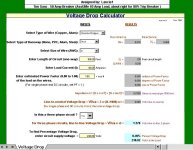Tim Ganz
Member
What is the correct size of THHN wire to be used for a 50 amp service (breaker Feeding is 50 amp)? The run is about 109 feet and I only have a 1990 seris ugly's book to go by. The closest table I have found is # 8 wire at 55 amps but it says no more than 3 insulated conductors in a conduit.
This circit will have 3 hot conductors and a insulated ground conductor so 4? Will the # 8 wire still be good.
This circit will have 3 hot conductors and a insulated ground conductor so 4? Will the # 8 wire still be good.




